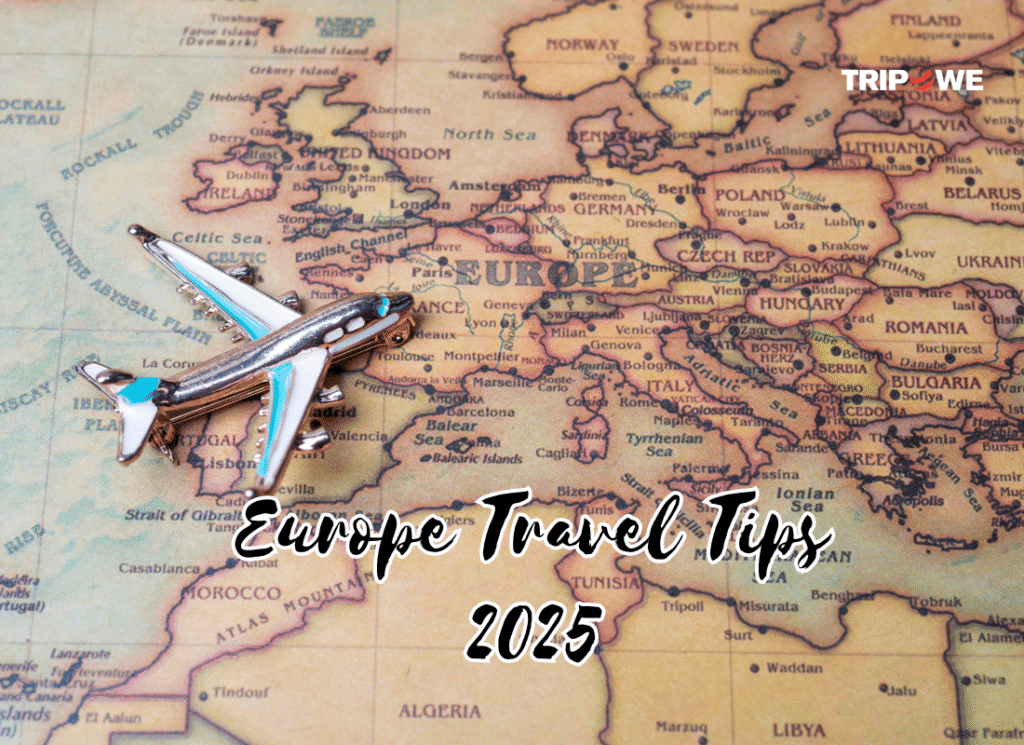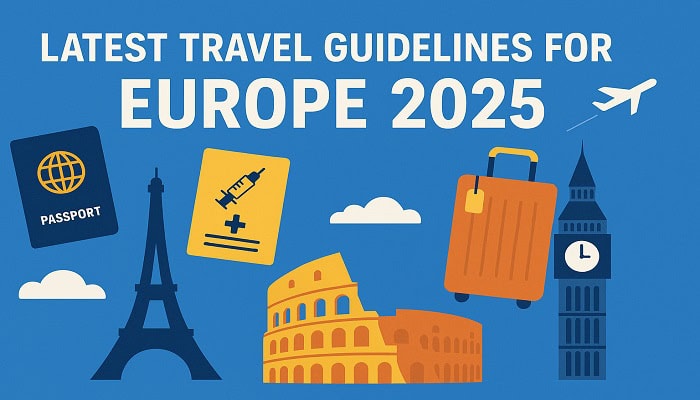Table of Contents
Introduction: Why Travel to Europe in 2025?
Europe remains one of the top global travel destinations, and in 2025, it’s more exciting than ever. With updated visa rules, eco-tourism incentives, digital nomad visas, and improved infrastructure across borders, traveling in Europe is easier, safer, and smarter. Whether you’re planning a luxury getaway to France, a budget backpacking tour through Eastern Europe, or a solo digital nomad journey, these travel tips are tailored for your best European experience in 2025.https://kanfservices.online/

🛂 1–5: Updated Visa, Entry & Border Rules (ETIAS 2025)
1. ETIAS Visa Waiver is Now Mandatory
Starting 2025, travelers from 60+ countries—including the US, UK, and Canada—must apply for the ETIAS (European Travel Information and Authorization System) before entering most Schengen countries.
🔗 Official ETIAS site
2. Check Entry Requirements by Country
Even within the Schengen Area, post-Brexit rules and dual agreements vary. Always check the embassy site of your first point of entry.
3. Biometric Border Checks Are Now the Norm
Most airports in Europe have installed biometric kiosks—have your passport ready and be prepared for facial recognition systems.https://kanfservices.online/
4. Multiple Country Visits? Plan Entry/Exit Carefully
Europe counts 90 days across Schengen zones. Make sure your itinerary doesn’t exceed visa-free limits.
5. Carry Digital & Physical Documents
Keep a PDF copy of your passport, visa, insurance, and vaccination certificates on your phone and in cloud storage.
💶 6–10: Budgeting & Currency Tips in 2025
6. Use Multi-Currency Travel Cards
In 2025, digital wallets like Revolut, Wise, and N26 offer fee-free currency exchange and budgeting features across the Eurozone.https://kanfservices.online/
7. Track Exchange Rates With Apps
Use apps like XE Currency or Google Finance to check live rates before exchanging.
8. Avoid Airport Currency Exchange
ATMs in city centers or your travel card are far more economical.

9. Travel in Shoulder Seasons
Prices in April–May and September–October are 30–40% cheaper than peak months (June–August).
10. Tipping Varies by Country
Tipping in France or Germany is optional (5–10%), but in Italy or Spain, it’s often included in service charge. Know the local customs.https://kanfservices.online/
🍃 11–15: Sustainable & Eco-Friendly Travel Hacks
11. Use Europe’s Expanding Rail Network
Trains are faster, greener, and now offer sleeper cabins (e.g., NightJet, ÖBB).
🔗 European Sleeper Trains – The Man in Seat 61
12. Book Eco-Certified Accommodations
Look for labels like EU Ecolabel, Green Key, or EarthCheck when booking hotels.
13. Avoid Over-Touristed Cities
Try alternatives like:
- Lecce over Florence
- Ljubljana over Prague
- Porto over Barcelona

14. Limit Flights Within Europe
Take trains, buses (FlixBus, BlaBlaBus), or car shares (BlaBlaCar) to reduce carbon footprint.
15. Pack Light & Plastic-Free
Use reusable toiletry kits, filtered water bottles, and eco-friendly sunscreens.
🛡️ 16–20: Health, Safety & Local Etiquette
16. Buy Travel Insurance With Health Coverage
Medical care in some EU countries can be expensive. Use global plans like SafetyWing or World Nomads.
17. Be Alert to Scams
Common scams include:
- Fake taxi meters in Budapest
- Overpriced bills in tourist zones of Romehttps://kanfservices.online/
- Distraction thefts in Paris or Barcelona
18. Understand Cultural Norms
In Northern Europe (e.g., Finland, Sweden), personal space is key. In Southern Europe (Spain, Italy), expect more expressive communication.
19. Emergency Number is 112
This works across all EU countries for police, ambulance, or fire.

20. Avoid Tourist Traps for Meals
Use Google Maps reviews or TheFork app to find well-rated local restaurants.
📲 21–25: Tech Tools & Digital Tips for Travelers
21. Use eSIMs for Europe
Avoid expensive roaming. Use apps like Airalo, Holafly, or Nomad for country-wide and EU-wide data plans.
22. Download Offline Maps
Google Maps, HereWeGo, or MAPS.ME can be lifesavers in no-signal zones.https://kanfservices.online/
23. AI Travel Planners Are Game-Changers
Apps like TripIt, Wanderlog, and AI-powered Google Travel now integrate full itineraries, visa checks, and weather forecasting.
24. Book Attractions in Advance
Popular spots like the Eiffel Tower, Sagrada Familia, and Colosseum are now digital-entry only. Book weeks in advance.
25. Scan QR Menus & Translate On-The-Go
Google Lens or iTranslate apps help you read menus, train signs, and directions in local languages instantly.
🎯 Best Times to Travel in Europe 2025
| Month | Best For |
|---|---|
| March–May | Tulip season in Netherlands, fewer crowds in Italy & Spain |
| June–July | Beach holidays in Greece, Croatia, Portugal |
| September | Wine harvest in France, Italy, and Spain |
| October | Oktoberfest in Germany, golden leaves in Czech Republic |
| December | Christmas markets in Austria, Germany, Switzerland |
🔗 Internal Links You Can Add (KANF Travel Blogs)
🌐 External Authority Dofollow Links (for SEO)
- ETIAS Visa Info – Official EU Site
- Seat 61 – Train Travel in Europe
- Virtuoso Luxury Travel Network
- Lonely Planet – Europe Guides
📲 Share This Post!
If this helped you plan your dream Eurotrip, share it with your friends:
#EuropeTravelTips2025 #SmartTravel #DigitalNomadEurope #SustainableTravel #KANFAdventures
✅ Final Thoughts
Europe in 2025 offers unforgettable experiences, but planning smartly is more important than ever. Use these expert tips—from visas to virtual tools—to travel confidently, safely, and sustainably.
Example Dofollow Outbound Links for Your Blog
- ETIAS Visa Info
Travelers must now apply for the ETIAS visa waiver before entering the Schengen zone in 2025.
- European Train Travel Guide
For sustainable travel, use Europe’s growing sleeper train network. Check routes on Seat 61, a trusted European train travel guide.
- Virtuoso – Luxury Travel in Europe
For curated luxury trips, explore experiences on Virtuoso, the global luxury travel network.
- Lonely Planet – Europe Travel Guides
Check Lonely Planet for expert insights and destination recommendations across Europe.
- TheFork Restaurant Booking App
Use TheFork to find and reserve quality restaurants across France, Italy, and Spain.
- Airalo – eSIM for Europe
Stay connected with affordable data from Airalo, offering regional eSIMs for Europe.
- XE Currency Converter
Get real-time exchange rates with XE Currency, especially helpful when hopping between countries.
- BlaBlaCar – Carpooling Across Europe
Save money and meet locals by booking rides on BlaBlaCar, Europe’s top car-sharing platform.
Final Thoughts: Travel Smart, Stay Inspired in Europe 2025
As you prepare to set off on your European adventure in 2025, remember that the heart of travel lies in the stories you collect, the cultures you embrace, and the memories you carry home. While tips and tools can certainly make your trip smoother, your attitude will shape the experience more than any itinerary ever could. This year, Europe is calling with a fresh energy—its historic cities infused with modern flair, its ancient traditions evolving with sustainability, and its people more welcoming than ever as tourism rebounds to new heights.
Navigating Europe in 2025 requires a mix of digital readiness and cultural awareness. Apps can help you translate menus, navigate transportation systems, and even find hidden local gems, but don’t let screens rob you of eye contact and serendipitous moments. Plan, but don’t overplan. Structure, but stay flexible. That spontaneous detour into a tiny French village or unplanned night listening to live jazz in Prague might become your most cherished memory.
Budgeting smartly will allow you to experience Europe without financial anxiety. From rail passes to travel insurance and cashless payment systems, technology has simplified travel logistics—but don’t forget to have some local currency for rural areas or markets. Likewise, packing light yet strategically can save you stress at airports and train stations, especially now that airline policies and cabin restrictions are becoming tighter across Europe. Stick to essentials, travel-friendly fabrics, and climate-appropriate gear depending on your route.
Don’t underestimate the value of cultural etiquette. A smile, a simple “hello” or “thank you” in the local language, or respecting local customs goes a long way. While English is widely spoken, making a small effort to speak the native language signals respect and often opens doors to deeper connections. In 2025, authenticity and human interaction are as valuable as 5G access or free Wi-Fi.
Travel in 2025 also requires responsibility. The European Union’s commitment to sustainable tourism is influencing everything from flight taxes to hotel energy ratings. Choosing green-certified accommodations, supporting local businesses, minimizing waste, and respecting heritage sites can amplify your positive impact. Tourists who understand they are guests, not consumers, often enjoy more meaningful and welcomed stays.
Above all, allow yourself the freedom to enjoy Europe—not just as a checklist of destinations but as a living, breathing cultural mosaic. Whether you’re sailing the Croatian coast, wandering through the Alps, exploring Roman ruins, or sipping espresso in a Lisbon cafe, these moments become part of your personal timeline.
Traveling to Europe in 2025 is more than a vacation. It’s a chance to rediscover the world—and yourself—with a renewed sense of curiosity, adaptability, and wonder. Embrace the journey fully and let every corner of Europe teach you something new.
❓FAQs: Europe Travel Tips for 2025
1. Is it safe to travel to Europe in 2025?
Yes, Europe remains one of the safest continents for travelers. Most major cities have low crime rates, and public transport is reliable. However, always stay informed via your government’s travel advisory, use common sense in crowded tourist areas, and consider purchasing travel insurance for peace of mind.
2. Do I need a visa to travel to Europe in 2025?
If you’re from the U.S., Canada, or many other countries, you’ll need to register under the ETIAS system (European Travel Information and Authorization System) starting in 2025. It’s a quick, online authorization required for entry into Schengen Area countries, valid for short stays up to 90 days within a 180-day period.
3. What is the best time to visit Europe in 2025?
Spring (April–June) and fall (September–October) are ideal for mild weather, fewer crowds, and lower prices. Summer (July–August) offers vibrant festivals and long daylight hours but comes with higher prices and packed attractions.
4. Is the Euro accepted everywhere?
Not everywhere. While the Euro (€) is the primary currency in most EU countries, others like Hungary (forint), Sweden (krona), and Switzerland (franc) use their own currencies. Always check the currency of the country you’re visiting and use multi-currency cards or local ATMs for the best exchange rates.
5. Can I use my phone and internet easily across Europe?
Yes. The EU abolished roaming charges for EU SIM card holders, and many global carriers offer competitive international plans. Consider purchasing an eSIM for Europe for data and calls if you’re visiting multiple countries. Free Wi-Fi is common in hotels, cafes, and even public areas.
6. What should I pack for Europe in 2025?
Pack light, breathable layers, comfortable walking shoes, a power adapter (type C or F), reusable water bottle, and anti-theft bag. Tailor your wardrobe based on the season and regions you’ll visit—light jackets for spring, sturdy boots for northern fall travel, and modest wear for religious sites.
7. Are train passes still worth it in 2025?
Absolutely. The Eurail Pass remains a great value for multi-country travel, especially for first-time visitors. With upgrades like mobile tickets, high-speed routes, and seat reservations via apps, it’s a flexible and sustainable option to explore the continent.
8. Is tipping expected in European countries?
Tipping is appreciated but not mandatory. In most countries, a 5–10% tip is sufficient in restaurants if service is good. For taxis or hotel staff, rounding up or offering a small token of thanks is customary. However, tipping etiquette varies by country—do a quick check before visiting.
9. How can I stay safe from pickpockets?
Stay alert in crowded areas like metro stations, tourist hotspots, and markets. Use crossbody or anti-theft bags, keep valuables secure, and avoid obvious displays of wealth. Travel insurance can also cover losses in some cases, so consider including theft protection in your policy.
10. Are there sustainable travel options in Europe?
Yes. Europe leads the way in eco-friendly tourism. Many cities offer bike rentals, green hotels, zero-emission tours, and carbon offset programs. Use public transport, avoid single-use plastics, support local artisans, and stay at eco-certified accommodations.

